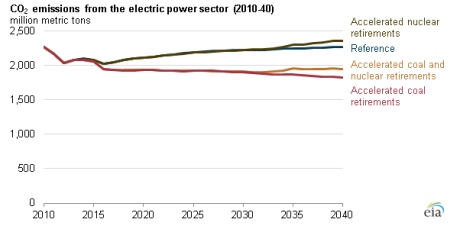The importance of preserving the existing US nuclear fleet was underlined by scenarios released by the US Energy Information Administration (EIA). Early retirement of nuclear, instead of coal, could see annual CO2 emissions 500 million tonnes higher by 2040.
Contributing to the EIA's Annual Energy Outlook 2014, which is being released in stages, Implications of accelerated power plant retirements looks at the effects of an accelerated rate of closure of both coal and nuclear plants going forward to 2040.
 |
| The worst thing for the environment would be for nuclear plants to close early (Image: EIA) |
As the EIA study points out, nuclear generation at four US nuclear power reactors - San Onofre 2 and 3, Kewaunee and Crystal River - has already been brought to an end because of operator decisions, with Vermont Yankee expected to end generation this year and Oyster Creek in 2019. "Retirements often are the result of unique circumstances, but some owners of nuclear power plants have voiced concerns about the profitability of their units, sparking discussion of possible additional nuclear retirements," the study noted.
The US Nuclear Energy Institute has said that "some of America's electricity markets are failing to accurately value the commodity's contribution to modern-day society. That is putting some nuclear energy facilities at risk of premature retirement despite excellent operations." The organisation's CEO, Marvin Fertel, said "Restructured, competitive markets can work effectively and efficiently, but today they are not producing price signals sufficient to stimulate investment in new electric generating capacity, with the exception of gas-fired plants, or to support continued operation of existing capacity." In some markets gas generation is exceptionally competitive, while at the same time renewable operators enjoy subsidies great enough to make money even when power prices are below zero. At these times, continuously operating nuclear power plants sometimes operate at a loss.
Although the EIA study did not address market issues, it presented an analogue in a scenario where some nuclear units close before the end of their 60-year operating life due to an assumed 3% year-on-year rise in fixed costs that would put stress on the competitiveness of older units. Including no additional nuclear capacity beyond the five units under construction today, the scenario indicates the resulting shortfall in generating capacity would primarily be met by a 13% increase in CO2-emitting natural-gas fired generation and a 5% increase in renewables, which are assumed to be non-CO2 emitting.
This loss of some 42 GWe of nuclear units without a drop in older coal plants results in electricity sector emissions 4% (85 million tonnes of CO2 per year) higher than EIA's reference scenario where nuclear costs do not rise and nuclear units retire at 60 years of age.
Similarly, a scenario which applies the annual 3% rise in fixed costs to coal units, in addition to a predicted rise in the cost of coal itself, would see many retirements of older coal plants. But with coal assumed to be replaced by lower-emitting sources like natural gas as well as renewables, electricity sector emissions would be 20% lower than the reference - a reduction of around 425 million tonnes per year in 2040.
The coal retirement scenario did not allow the possibility that nuclear power could grow in response to market changes, and both scenarios had natural gas as the main beneficiary of retirements.
Researched and written
by World Nuclear News




_18570.jpg)
_16159.jpg)
_18938.jpg)
_33584.jpg)





